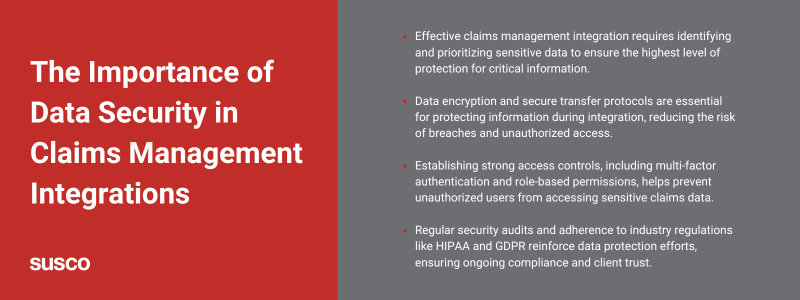
Imagine an insurance adjusting (IA) firm integrating a new claims management system, transferring sensitive data on active claims, policyholders, and financial details.
During this process, a minor security lapse results in unauthorized access, exposing clients’ personal information. The fallout? Compromised client trust, potential legal ramifications, and a damaged reputation.
This scenario highlights why data security is essential in claims management integrations. Protecting sensitive information from breaches prevents these costly risks and ensures compliance with industry standards.
When IA firms approach integrations with security at the forefront, they safeguard their operations and set the foundation for trusted, resilient claims management systems.
Data Security Best Practices During Integration
IA firms must prioritize data security best practices at every stage to ensure secure integration. Given the high volume of sensitive information, taking a proactive approach to data protection isn’t just beneficial—it’s essential.
Implementing robust security measures during integration safeguards client data, reduces the risk of breaches, and ensures compliance with industry standards, ultimately supporting a reliable, trustworthy claims management process.
Encryption and Secure Data Transfer
Encryption is critical for protecting data as it moves between systems. Implementing advanced encryption protocols ensures that data remains secure during transfer, reducing the risk of interception.
This applies not only to the integration phase but also to ongoing data exchanges post-integration.
Access Controls and User Authentication
Robust access controls and user authentication protocols limit access to authorized personnel only, significantly reducing the risk of unauthorized access.
Setting up multi-factor authentication (MFA) and role-based access ensures that sensitive data is only accessible to those who need it, adding an extra layer of security.
IA firms protect their clients and operations by adopting strong data security practices during integration. Encryption, access controls, and secure authentication aren’t just technical requirements—they’re foundational elements that reinforce trust and resilience in claims management systems.
With these measures in place, IA firms can confidently navigate the complexities of data integration, ensuring that sensitive information is secure during and after the process.
Protecting Sensitive Information
Not all claims data is equally sensitive, making it essential to identify and prioritize which information requires the highest level of protection. In claims management, data spans a wide range—from general policy details to highly sensitive personal identifiers and financial information.
By carefully classifying claims data based on sensitivity, firms can apply tailored security protocols that offer maximum protection where it matters most.
Classifying and Prioritizing Data
Sensitive information, such as personal identifiers (e.g., Social Security numbers) and financial data, needs specific protection measures during integration. By classifying data, IA firms can apply tailored security controls where required.
Safeguarding Personal and Financial Information
Handling personal and financial information requires heightened security protocols. Encrypting databases that store this information, anonymizing data where possible, and restricting internal access based on roles help prevent data leaks and safeguard client privacy.
Compliance and Regulatory Considerations
Maintaining compliance with industry standards is a legal obligation and a best practice that reinforces data security.
Industry Regulations and Standards
Compliance with HIPAA (Health Insurance Portability and Accountability Act) and GDPR (General Data Protection Regulation) is essential for handling claims data. These regulations mandate specific measures for protecting sensitive information, including audit logs and user consent.
Regular Security Audits and Checks
Conducting security audits during and after integration ensures ongoing protection and compliance. Regular checks for vulnerabilities, updating security protocols, and testing for potential breaches are essential to safeguard data over time.
When sensitive information is appropriately classified and secured, IA firms protect their client’s privacy and strengthen their operations’ integrity.
These extra layers of protection—such as encryption, access controls, and data anonymization—are essential to preventing unauthorized access and potential data breaches.
Taking a proactive approach to data security demonstrates a commitment to compliance and client trust. It guarantees client information remains confidential and secure even as systems integrate and evolve.
Risk Management and Incident Response Planning
While securing data during integration is critical, IA firms must also be prepared for unexpected security incidents. A strong risk management and incident response plan ensures that your team can swiftly handle breaches, reducing the impact on operations, clients, and data integrity. By preparing proactively, IA firms can minimize downtime, protect sensitive information, and uphold client trust even in challenging situations.
Critical Components of an Effective Incident Response Plan
1. Risk Assessment and Vulnerability Testing
Before integration begins, perform a comprehensive risk assessment to identify potential vulnerabilities in legacy and new systems.
2. Defined Roles and Responsibilities
An effective response relies on clarity. Assign team members specific roles and responsibilities for each step of the incident response process, including data containment, recovery, and communication.
3. Incident Detection and Monitoring
Implement real-time monitoring tools to detect unusual activity and alert your team immediately.
4. Containment and Recovery Procedures
Containment is crucial to stopping further damage. Have a clear plan for isolating affected systems, securing backup data, and initiating recovery steps.
In claims management, data security during system integration is non-negotiable. Following these security best practices—from encryption and access controls to compliance measures—IA firms can protect sensitive information, maintain regulatory compliance, and build client trust.
Susco Has Solutions
Ensure your claims integration is secure and compliant—contact Susco for expert data security solutions. We can help you build a custom CMS with advanced analytics and reporting capabilities and seamless integration with all your systems.
Start the conversation and propel your move toward a data-driven future.